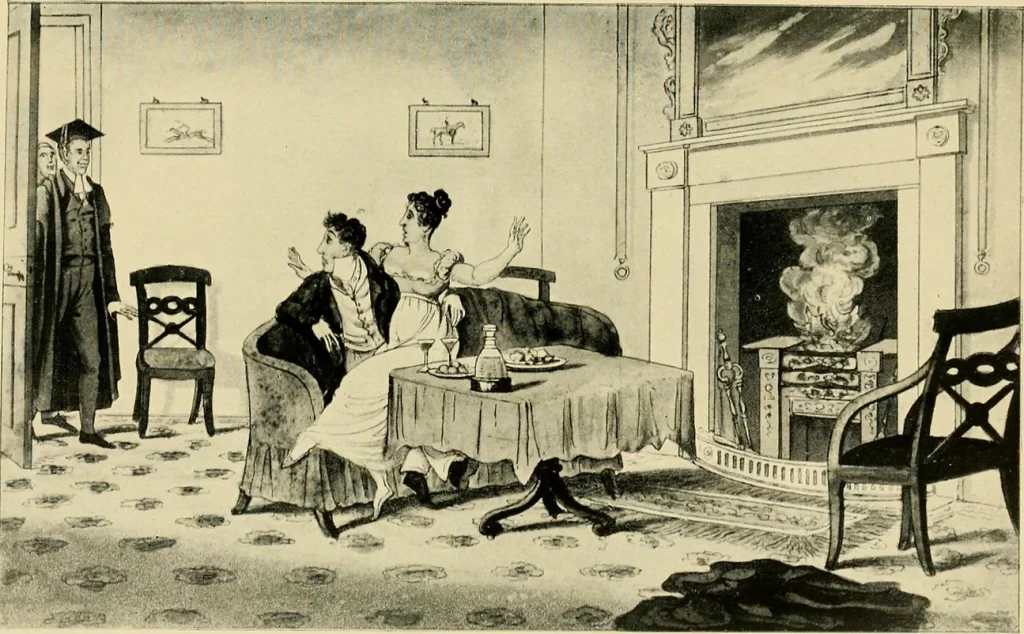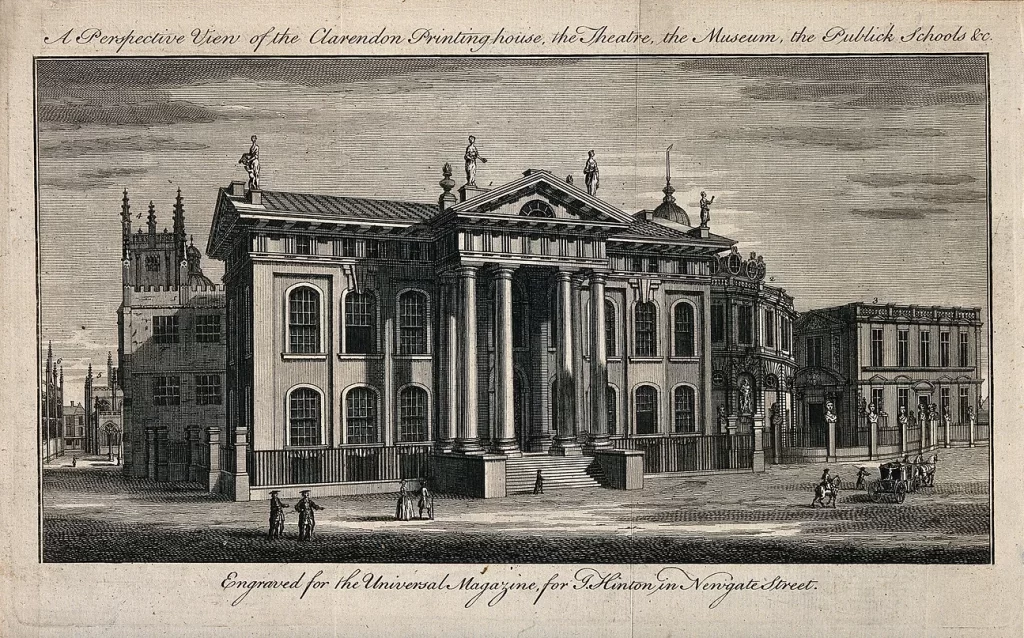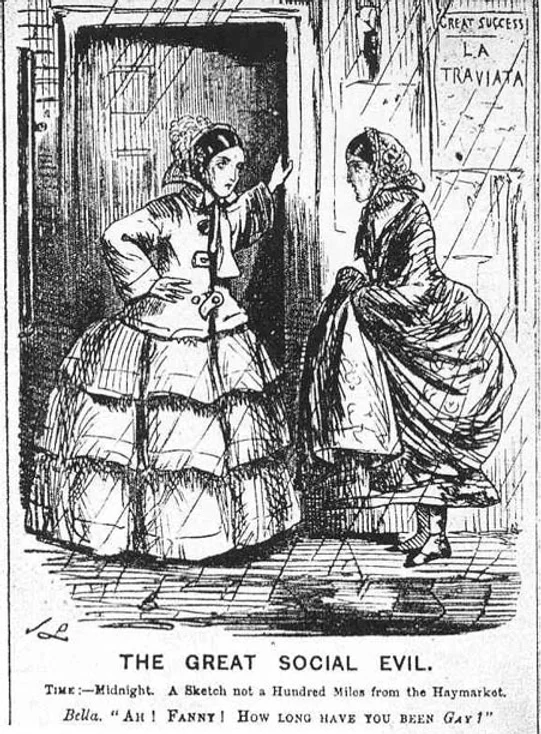Until the late 1870s, the University of Oxford was an all-male institution, frequented by young students of rich and privileged backgrounds. Yet coming to Oxford, the pinnacle of many educations, had its own air of danger; there, for the first time, the students had a newfound freedom to interact with women, themselves formally outside of the University’s control. The combination of masculinity, wealth, and youth thus created a unique and lucrative market for prostitution and resulted in policing women. Learn about wealth and class inequality in Oxford on our Follow the Money tour.
“University police officers, called Proctors, who are clergymen, are appointed to prevent, as far as they can, debauchery, gross immorality, and public disturbances. The college windows are barred like those of prisons, to prevent egress and ingress; but ecclesiastical vigilance is not a match for the depravity of the students in general; and thus they hold communication, if no Proctor is in sight, with prostitutes through the iron-barred windows. And it must be fresh in everybody’s recollection, that the young woman who was so inhumanly murdered lately in that city, had just previously to the awful occurrence been drinking brandy, handed to her through the bars of one of the windows of Brazen Nose college. […]
– Thomas Parkin, An Exposure of Religious and Civil Despotism, 1828.

Policing women’s appearances and the places they visit tragically returned to the centre of public discourse during international women’s week 2021, sending a shock wave across the nation. Yet the issue of women’s right to walk the streets is nothing new; in nineteenth-century Oxford, the city’s famed university went to great lengths to control, police, and punish working townswomen suspected of ‘immoral intentions.’[1]
The logic behind this policy was both gendered and elitist. Until the late 1870s, the University of Oxford was an all-male institution, frequented by young students of rich and privileged backgrounds. Yet coming to Oxford, the pinnacle of many educations, had its own air of danger; there, for the first time, the students had a newfound freedom to interact with women, themselves formally outside of the University’s control thus opening the need for policing women. The combination of masculinity, wealth, and youth thus created a unique and lucrative market for sex work. Historian Arthur Engel estimated that in the 1830s, while the city contained about 25,000 inhabitants and roughly 1,500 students, police records showed between 300 and 500 “common prostitutes”, an impressively high ratio.[2]
Oxford’s transient population of young men also attracted seasonal sex work migrations during the university terms, a tendency that worried both local and academic authorities. Initially, the university’s vice-chancellor utilized the criminalization of vagrancy to imprison large numbers of presumed sex workers in the city jails. Yet, when the law relaxed in 1826, the university decided to take over the financial burden of catching, detaining, and punishing suspect women, a group that the local law enforcement did not prosecute to the same extent. For the best part of the nineteenth century, the Night Watch (a separate police force on the university payroll) obtained full jurisdiction over the city of Oxford from the 9pm curfew to 4am. The suspected prostitutes were no longer jailed in the city prison but were now kept overnight in underground ‘rooms’ below the Clarendon Building and presented to the vice-chancellor the following morning to hear their sentence.

Although this policing arrangement relieved the city from overseeing a situation that was amplified by the presence of a prestigious male university, it certainly strained the relationship between town and gown. First, the risk of a townswoman being imprisoned by mistake placed a stronger emphasis on policing women appearance; typically, any woman seen walking with an uncovered head could be suspected of sex work, and all women had to take extra care to look respectable and avoid some areas. Secondly, the intense criminalization of women in Oxford created new invisible borders between the city and nearby towns, such as Woodstock and Abingdon, where prostitution practices fell outside the university’s control. Finally, the Night Watch had the power to enter any house where an undergraduate student might be caught with a woman, thus increasing the police’s power of harassment, and placing the whole city under university surveillance. Metaphorically, it also associated all public spaces and local houses with transgression and vice.
However, the University of Oxford’s obsession with the morality of its own students provides interesting avenues to learn more about women who lived in Oxford in the nineteenth century, and how they interacted with the students. In particular, the criminalization of prostitution highlights dynamics of class and mobility. Most of the women imprisoned for streetwalking often worked several different jobs, and sex work was just one way of earning money. Many women also worked as Oxford servants, especially those who came from the nearby villages. Given the near-monastic lifestyle expected from the students, sex work was nothing new; in 1461, medieval Oxford’s chancellor banned from “a circumference of ten miles around the said University all bawds, whores, and incontinent women.”[3] Women who were caught were then sometimes condemned to the pillory and public humiliation.
In the 19th century, the rise of the Oxford’s Night Watch was concurrent with the University of Cambridge’s ‘Spinning House’ prison [4], and of the controversial Contagious Diseases Acts: all aimed at labelling public women, controlling their bodies, and segregating them spatially and socially. At the same time, the Holywell Manor House, today the residence of Balliol College’s graduates, became the Oxford Female Penitentiary, with the declared purpose of rescuing fallen women. From 1857 to 1929 it hosted on average thirty penitents each year, the majority born outside of Oxfordshire, and was used as an additional tool to regulate female mobility into the city. During those decades, women were also punished on average more systematically than their student partners; the fault was always assumed to lie with the women, who were directly taken into custody, while the male undergraduates only had to swear that they had no lewd intentions.

Ultimately, the criminalization of the relationship between male students and townswomen also delayed the admission of women into the university, by fuelling the arguments of those who feared the immoral consequences of women coming into higher education, another example of policing women. In 1914, on the eve of the first world war, the proctors’ fine books still contained a meticulous classification of the types of women who could be found in Oxford, ranging from ‘respectable’ women to those of ‘dubious’ and even ‘bad’ character; despite women’s admission into the university in 1879, their moral standards were always in question.[5] As a result, the first female students were under strict chaperoning rules and had to constantly regulate their own movement in the city as well as their physical appearance. In the detective novel Gaudy Night, taking place in a women’s college, the main character thus criticizes a curfew-breaking fellow undergraduate for fear of the bad reputation that might extend onto all the female students.[6]
The emphasis on policing women’s mobility and bodies in Oxford was eventually undermined by changes to the profile of the typical Oxford student; as men of lower income backgrounds started coming in, sex work declined. Many of those students also started to live in private lodgings in the city, creating a different standard of living. Controlling morals was no longer about just controlling prostitution. The story of Oxford’s Night Watch might thus come across as an interesting relic of the past, evoking the elitism, gender segregation, wealth, and town-gown divisions of a previous age. Nonetheless, recent events have proven that such problems might not be as archaic as we might think, for even today challenges to women’s behaviour and appearance on the streets – and even their right to be there at all – remain all too common. Policing women in public places is not yet over.
Want to continue learning about women in Oxford? Read our blog article on the 1880s and the growth of female suburbs.
Written by Olivia Durand
References
[1] Engel, Arthur J. “‘Immoral Intentions’: The University of Oxford and the Problem of Prostitution, 1827- 1914.” Victorian Studies 23, no. 1 (1979): 79-107.
[2] Ibid. Engel, Arthur J.
[3] Karras, Ruth Mazo. Common Women : Prostitution and Sexuality in Medieval England, Oxford University Press, 1996.
[4] Bogen, Anna. Women’s University Fiction, 1880-1945, Taylor & Francis Group, 2015: “The notorious ‘Spinning House’ at Cambridge, which began as an eighteenth-century workhouse, was used specifically to house prostitutes arrested by the university proctors, who retained the nominal right to do so, over the wishes of the town, until 1983.” See also, Oswald, Janet. “The Spinning House Girls: Cambridge University’s Distinctive Policing of Prostitution, 1823–1894.” Urban History 39, no. 3 (2012): 453-70.
[5] Ibid Bogen, Anna. Also: Bartley, Paula, and Paula Bartley. Prostitution : Prevention and Reform in England, 1860-1914, Taylor & Francis Group, 1999. The first women’s colleges opened in 1879 (Lady Margaret Hall and Somerville College) but women were only accepted as full members of the University in 1920.
[6] Sayers, Dorothy L. Gaudy Night. London, 1935. The women’s college was Somerville.


